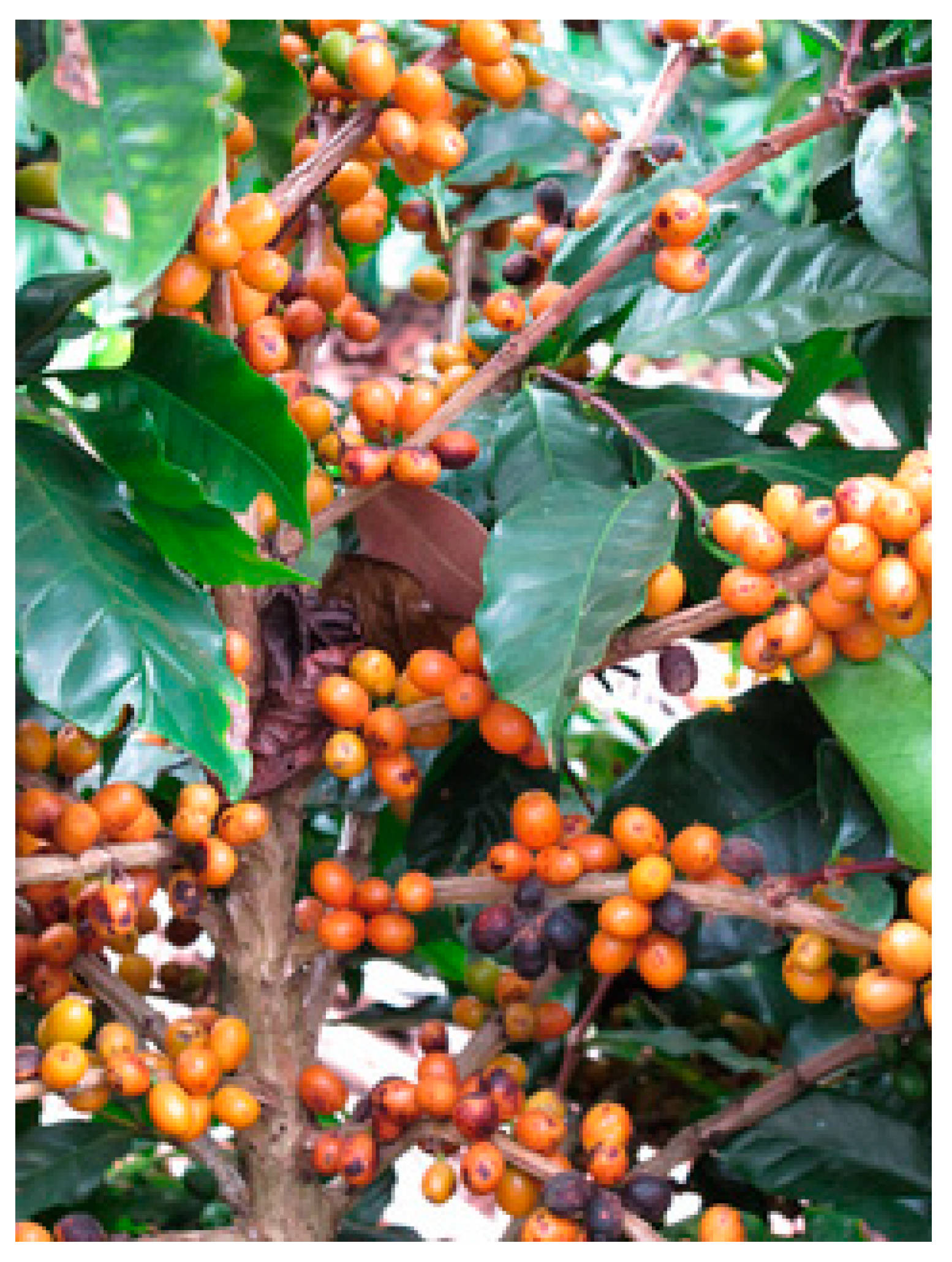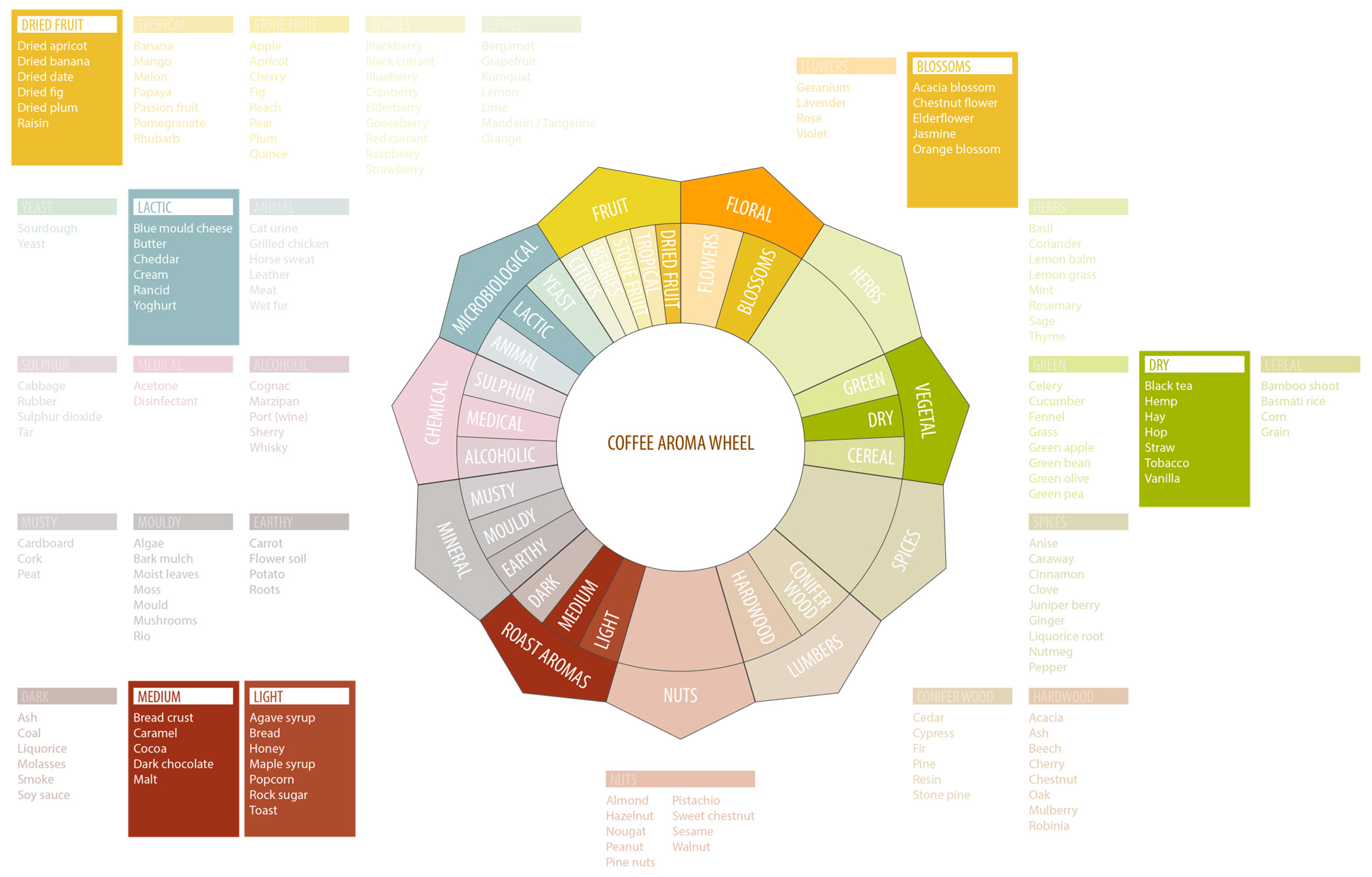1. Introduction
Coffee by-products are all of interest as all parts of the coffee plant can be utilized [
1] in commercial products (
Figure 1).
Parchment (from the hulling process), wood, leaf and cascara might be used for the production of energy (the most sustainable way: biogas [
2]) and organic fertilizer [
3,
4] (nutrient ash, terra preta), but the best way is to process suitable raw materials into more valuable goods.
Coffee leaf and cascara already have EU clearance to be used as food. Both are traditionally consumed in tea-like beverages (coffee leaf: amertassa, kati; cascara: Qishr). The silver skin isolated in coffee roasting is currently part of an EU novel food application, however it has been consumed with roasted coffee long before the EU was founded. Of these materials, cascara would be the only by-product removed from the flow of green coffee production.
2. Methods
The scientific view on the coffee by-product cascara reflected and summarized in typical review articles such as [
1] almost always results in ingredient tables with numbers for sugar and caffeine content, etc., but seldom adequately describes typical food attributes like flavour and taste. The general viewpoint seems to be that the potential isolation of materials from the cascara can be used in the food industry, rather than considering the potential of cascara as a valuable stand-alone fruit product. A closer look at coffee production explains why the potential of cascara is mainly discussed from the valuable-ingredients point of view. Green coffee production is centred around the seed, following the mantra of not harming the seed and not causing the seed to grow a plant. This is easily achieved with the processing of coffee cherries which is unlike other food processing and carries dust, twigs, stones etc., through the processing line (see
Figure 2) as the coffee seed is well protected and can be considered a living organism covered by plant building material, well protected against microbial attack by silver skin and wrapped in parchment.
The fruit part (dead part of the cherry to be digested) however does degrade in flavour and taste if removed under these conditions and even seamless and proper drying will not bring back the typical stone fruit flavour profile with its vivid acidity and a fresh and clean taste. Applying the excellent coffee consulate FlavourProfile [
5] for flavour and taste evaluation in coffee, cascara samples of different origins were analysed by a professional tasting panel utilizing the respectively calibrated TasteKit [
5].
Scheme 1 shows the typical flavour compounds and taste profiles of cascara brewed as a tea (12 g of cascara, 1 L of water with total hardness of 5 degrees at 92 °C and 4 min steeping time), with the cascara coming from standard coffee production work units (best case scenario).
Processing coffee cherries under optimum food conditions (prompt processing of harvested ripe cherries via picking method with flotation, thorough cleaning, and minimum invasive removal of fruit part) and with proper drying reveals the full potential of cascara. Results of cascara tea preparation are shown in
Scheme 2.
According to caffeine content, other valuable ingredients, and flavour, cascara from actual green coffee processing is mainly attractive as an ingredient in beverages containing sugar and additional flavour compounds to mask potential off-taste. Cascara production will require quite an effort as the material will have to be dried properly which is critical during harvest. The minimum cascara price to suit the farmer and ensure product safety will be in the range of green coffee prices.
3. Results and Discussion
Selling waste does not represent a long-term solid financial base for the typical coffee farmer. Indeed, selling green coffee waste has already been proven to keep coffee prices low and not pay well for the high effort. As even standard cascara is valuable (in the price region of green coffee) for the farmer, investing in new green coffee production and manufacture which covers the cascara fruit (containing water recycling and cleaning) is manageable and would pay back faster, leading to a sustainable situation for the farmer and nature. The food processing of coffee cherries will open the possibility of all different fruit products imaginable and will have a huge positive impact on green coffee quality. A farmer aiming for sustainable coffee production has two options: to either produce sought-after speciality products, and/or to convert his by-products into energy or fertilizer in order to not be solely dependent on big industrial players as is common in the tense environment of bulk coffee production.








